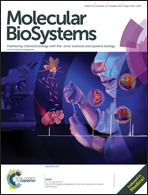An immunoinformatics approach to promiscuous peptide design for the Plasmodium falciparum erythrocyte membrane protein-1†
Abstract
Plasmodium falciparum erythrocyte membrane protein-1 (Pfemp-1), a variant adhesion molecule, can act as a key component of immunity against malaria. In the current selection of malaria vaccines, no efficient vaccines are available that can be employed for its proper treatment. Unfortunately, resistance to post-infection treatments is increasing and therefore there is a pressing need to develop an efficient vaccine. Peptide-based vaccines can be effective tools against malaria but HLA restriction is a major hindrance which can be conquered by using promiscuous peptides. In this work, we employed a combined in silico and experimental approach to identify promiscuous peptides for the treatment of malaria. At first, using the immunoinformatics approach, promiscuous peptides were predicted from two conserved domains, CIDR-1 and DBL-3γ, of the Pfemp-1 antigen. These peptides were selected on the basis of their predicted binding affinity with different HLA class-I & class-II alleles. A total of 13 peptides were selected based on their predicted IFN-γ and IL-4 induction ability as well as their hydrophobicity. Out of these 13, the peptide C6 was synthesised and experimentally evaluated for further rationalization, HLA–peptide complex modelling and binding interaction analysis. Interestingly, the peptide C6 (SFIHIYLYRNIRIQL) showed an encouraging immunological response and T-cell proliferation in the immunological assay. This valuable content can aid the better design of more potent and selective vaccine candidates against infectious diseases.



 Please wait while we load your content...
Please wait while we load your content...